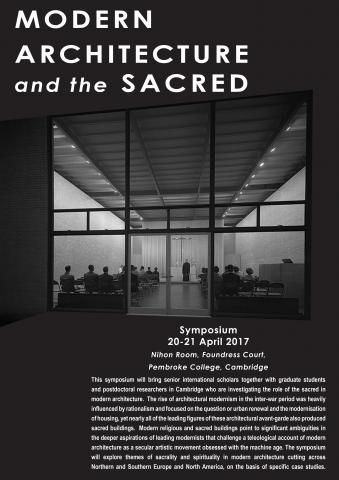This project is based on a symposium held in Cambridge in April 2017, co-convened by Maximilian Sternberg and Ross Anderson from the School of Architecture at the University of Sidney. The international symposium attracted contributions from leading academics, mid-career researchers and advanced doctoral candidates who are engaged in different ways with questions of architecture and the sacred. The individual papers have subsequently been developed to become chapters of a forthcoming volume co-edited by Sternberg and Anderson, under contract by Bloomsbury Academic.
This edited book is a timely reappraisal of architecture’s manifold engagements with the sacred in the Western cultural context of Late Modernity. Following the recalibration of cultural values in the Enlightenment period that promoted the removed clarity of logic and reason over tradition, sacred architecture became deeply problematic. Unable to self- evidently rely on conventional ways of conceiving and carrying out religious buildings, architects and their patrons turned variously to the sciences or the fine arts for models of making. Originally couched within notions of architectural styles and building types, with the ascendency of international avant-garde movements in the early 20th century discussions turned to tectonics, space, transparency and abstraction. Yet, paradoxically, many avant-garde architects, including Le Corbusier, Peter Behrens, Mies van der Rohe, and Auguste Perret, also designed churches and other buildings that have a degree of sacrality, such as cemeteries and mausolea. They also designed buildings such as museums, exhibition pavilions and memorials that make more or less explicit claims to some form of secular-sacred. Interestingly, these buildings are often difficult to situate within each architect’s œuvre, often appearing dark, regressive or eccentric. The compulsion to engage with the often-awkward issues of sacred architecture was rooted in a desire to compensate for the perceived spiritual void in modern life, cleft between Rationalism and Romanticism.
This book seeks to appropriately recognise and interrogate the significant ambiguities in the religious or semi-religious buildings by modern architects, thereby unsettling the traditional account of modern architecture as a secular movement attuned on one hand to high technology, and on the other to the individual artistic genius. Collectively, the chapters in this book mount an argument that the significant corpus of sacred or semi-sacred buildings by modern architects should no longer be dismissed as peripheral phenomena. On the contrary, they have much to reveal to us about the deeper motivations and complexities that are at the core of the project of modernism.

